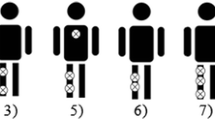Abstract
With the development and popularization of virtual reality and motion capture technology, physical therapists have had a new option to improve patient rehabilitation effectiveness. However, there were few studies in the past focusing on total knee replacement (TKR) rehabilitation solutions and many restrictions on the assistance devices. This paper aims to explore how users’ motivation and perception of system usability affect rehabilitation performance in a 3D game-based rehabilitation environment. Further, we examine the feasibility of applying Kinect-based method in rehabilitation activities to improve performance. A system called the Physical Rehabilitation System (PRS) was developed and deployed in a one-week TKR rehabilitation process. 27 TKR rehabilitants were divided into a control group (N = 11), and an experimental group, which was rehabilitated with a PRS (N = 16), and had, also, to fill out a questionnaire. The group with higher performances generally had stronger motivation and a better evaluation on a PRS (p < .05). The experimental group showed greater improvement with an average knee-bending angle of 109.38. This study shows that motivation influences the effectiveness of rehabilitation, and that PRS acceptance by rehabilitants was indeed able to strengthen their motivation and improve their rehabilitation outcomes.






Similar content being viewed by others
References
Alankus G, Proffitt R, Kelleher C, Engsberg J (2010) Stroke therapy through motion-based games: a case study. ASSETS 2010: proceedings of the 12th international ACM SIGACCESS conference on computers and accessibility. ACM, Orlando, Florida, USA. New York, pp 219–226, 2010 Oct 25–27
Betker AL, Desai A, Nett C, Kapadia N, Szturm T (2007) Game-based exercises for dynamic short-sitting balance rehabilitation of people with chronic spinal cord and traumatic brain injuries. Phys Ther 87:1389–1398
Brooke J (1996) SUS: a “quick and dirty” usability scale. In: Jordan PW, Thomas B, Weerdmeester BA, McClelland IL (eds) Usability evaluation in industry. Taylor & Francis, London, pp 189–194
Chan DKC, Hagger MS, Spray CM (2011) Treatment motivation for rehabilitation after a sport injury: application of the trans-contextual model. Psychol Sport Exerc 12:83–92
Chang YJ, Chen SF, Chuang AF (2011) A gesture recognition system to transition autonomously through vocational tasks for individuals with cognitive impairments. Res Dev Disabil 32:2064–2068
Chen YP, Kang LJ, Chuang TY, Doong JL, Lee SJ, Tsai MW et al (2007) Use of virtual reality to improve upperextremity control in children with cerebral palsy: a single-subject design. Phys Ther 87:1441–1457
Deci EL, Ryan RM (1985) Intrinsic motivation and self-determination in human behavior. Plenum, New York
Delaney HD, Vargha A (2002) Comparing several robust tests of stochastic equality with Ordinally scaled variables and small to moderate sized samples. Psychol Methods 7:485–503
Deutsch JE, Borbely M, Filler J, Huhn K, Guarrera-Bowlby P (2008) Use of a low-cost, commercially available gaming console (Wii) for rehabilitation of an adolescent with cerebral palsy. Phys Ther 88:1–12
Jack D, Boian R, Merians S, Tremaine M, Burdea GC, Adamovich SV et al (2001) Virtual reality - enhanced stroke rehabilitation. IEEE T Neur Sys Reh 9:308–318
Keller JM (1983) Motivational design of instruction. In: Reigeluth CM (ed) Instructional-design theories and models: an overview of their current status. Lawrence Erlbaum Associates, New York, pp 386–434
Kubeck JE, Delp ND, Haslett TK, McDaniel MA (1996) Does job-related training performance decline with age? Psychol Aging 11:92–107
Levac D, Pierrynowski MR, Canestraro M, Gurr L, Leonard L, Neely C (2010) Exploring children’s movement characteristics during virtual reality video game play. Hum Movement Sci 29:1023–1038
Lotan M, Yalon-Chamovitz S (2010) Weiss PL. Virtual reality as means to improve physical fitness of individuals at a severe level of intellectual and developmental disability. Res Dev Disabil 31:869–874
O’Connor TJ, Cooper RA, Fitzgerald SG, Dvorznak MJ, Boninger ML, Vansickle DP et al (2000) Evaluation of a manual wheelchair interface to computer games. Neurorehabil Neural Repair 14:21–31
Reinen IJ, Plomp T (1997) Information technology and gender equality: a contradiction in terminis? Comput Educ 28:65–78
Rizzo AA, Buckwalter JG, Neumann U (1997) Virtual reality and cognitive rehabilitation: a brief review of the future. J Head Trauma Rehabil 12:1–15
Rizzo AA, Kim GJ (2005) A SWOT analysis of the field of VR rehabilitation and therapy. Presence-Teleop Virt 14:119–146
Rose FD, Brooks BM, Attree EA, Parslow DM, Leadbetter AG, McNeil JE et al (1999) A preliminary investigation into the use of virtual environments in memory retraining after vascular brain injury: indication for future strategy? Disabil Rehabil 21:548–554
Sayenko DG, Masani K, Robinson MF, Vette AH, McConville KMV, Popovic MR (2011) Video game-based neuromuscular electrical stimulation system for calf muscle training: a case study. Med Eng Phys 33:249–255
Schultheis MT, Rizzo AA (2001) The application of virtual reality technology in rehabilitation. Rehabil Psychol 46:296–311
Shaughnessy M, Resnick B, Macko R (2006) Testing a model of post-stroke exercise behavior. Rehabil Nurs 31:15–21
Siegel S, Castellan NJ Jr (1988) Nonparametric statistics for the behavioral sciences, 2nd edn. McGraw-Hill, New York, 399 pp
Tondeur J, Valcke M, van Braak J (2008) A multidimensional approach to determinants of computer use in primary education: teacher and school characteristics. J Comput Assist Lear 24:494–506
Vargha A, Delaney HD (2000) A critique and improvement of the CL common language effect size statistic of McGraw and Wong. J Educ Behav Stat 25:101–132
Weiss PL, Rand D, Katz N, Kizony R (2004) Video capture virtual reality as a flexible and effective rehabilitation tool. J Neuroeng Rehabil 1:1–12
Wood SR, Murillo N, Bach-y-Rita P, Leder RS, Marks JT, Page SJ (2003) Motivating, game-based stroke rehabilitation: a brief report. Top Stroke Rehabil 10:134–140
Author information
Authors and Affiliations
Corresponding author
Rights and permissions
About this article
Cite this article
Su, CH. Developing and evaluating effectiveness of 3D game-based rehabilitation system for Total Knee Replacement Rehabilitation patients. Multimed Tools Appl 75, 10037–10057 (2016). https://doi.org/10.1007/s11042-015-2820-1
Received:
Revised:
Accepted:
Published:
Issue Date:
DOI: https://doi.org/10.1007/s11042-015-2820-1




